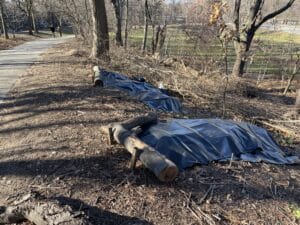Sun Power for Parks
June 6, 2023
Walking through Brooklyn’s Backyard on any given day, it’s clear that creativity is key for the Prospect Park Alliance Landscape Management team. Their essential work to sustain the park’s natural areas has included an array of unlikely, environmentally friendly techniques that make use of everything from cardboard and piles of leaves to even sheets of plastic. In one technique called solarization, dedicated Alliance staff and volunteers use plastic and the power of the sun to ward off invasive plants that can outcompete native species that park wildlife depend upon.
The crew experimented with this approach this winter: tailoring their methods on an as needs basis, determining the plastic’s color and thickness through careful consideration of the location, terrain and targeted plants. “Solarization trials in full sun locations have been the most successful—particularly with two sections in the Vale Woodlands, an area restored by Prospect Park Alliance following Superstorm Sandy,” says Landscape Management Deputy Director Mary Keehbauch. “The biggest take away is that no one rule applies to every situation. Everything we do is site specific, and being creative and willing to try different methods is essential. Not all trials are successful, but we are committed to getting the best results possible.”

Before and After of a solarized area in the Prospect Park Vale, where the target species, Goutweed, is almost entirely gone thanks to the team’s implementation of this technique. Courtesy of Mary Keehbauch, Prospect Park Alliance
Each plastic has its specific use. Black plastic blocks light and heats the roots of an invasive plant once it has been cut down, and remains in place for at least full year; while clear plastic is used in shorter increments, in areas of direct sunlight to stop the plant’s growth, heat up the soil to destroy the roots, and rid the soil of any remaining seeds. The end result is soil that is ready to be planted with native, pollinator-friendly plants that will help Prospect Park’s ecosystem thrive. The solarization of a given area can span anywhere from two months to two or more years, and the team plans to build on its progress by assessing which approach is most successful in what conditions, implementing the technique in new areas of the park, assessing progress and monitoring results as this work continues.

The type of terrain, access to sun, and target species are all major factors in the Alliance’s work to refine its solarization technique for varying areas. Courtesy of Mary Keehbauch, Prospect Park Alliance.
Building on the successes seen in the Vale and beyond, the team has plans to use solarization to eradicate dense Wintercreeper (Euonymus fortunei) near the Golden Stairs–located between 10th Avenue and 16th Street park entrance–with thick black plastic and to knock-out Goutweed (Aegopodium podagraria) near the 3rd Street Entrance with thin clear plastic. Following successful solarization, the Alliance will restore the areas with a wide range of native species, from beautiful spring ephemerals to strong healthy trees that will provide a haven in the park for generations to come. Asked how park goers can help the Alliance in these efforts to keep Brooklyn’s Backyard green, vibrant and healthy, Keehbauch shares a reminder that while these projects are eye-catching, and openings in the woodlands are tempting for discovery, it is important that everyone in the park respects the work being done and stays on the paved or wood chipped trails to keep the park healthy.